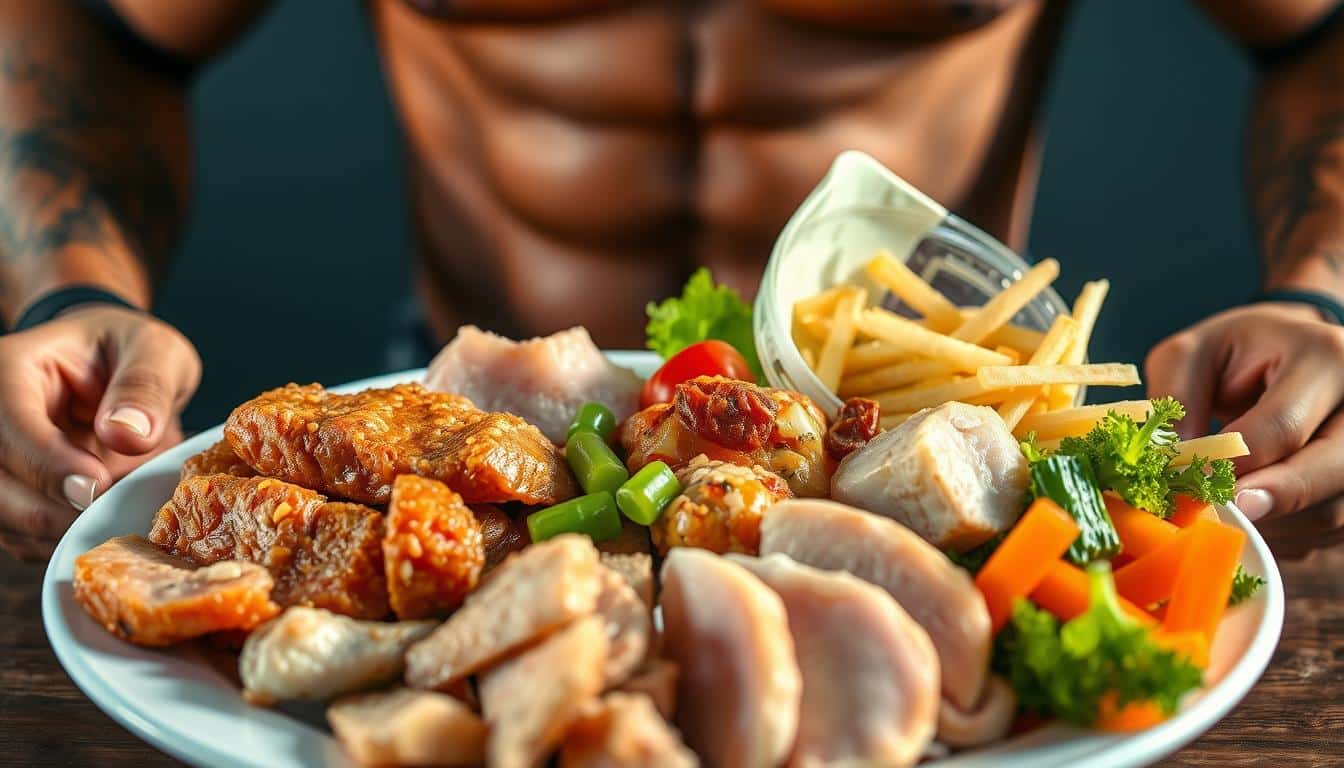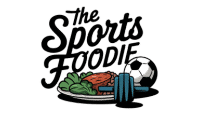Did you know that some NFL players consume up to 7,000 calories a day during training camp? That’s more than triple what the average person eats! Nutrition has become a game-changer in professional football, with teams like the Miami Dolphins and Los Angeles Rams investing heavily in top-notch food services.
Proper nutrition isn’t just about eating more—it’s about fueling the body for peak performance and faster recovery. Teams now work with dietitians to create custom meal plans tailored to each player’s needs. Whether it’s pre-game meals or post-game recovery, every bite counts.
In this guide, we’ll break down the essentials of an effective diet for NFL players. From nutrient needs to meal planning, you’ll discover actionable steps to optimize performance on and off the field. Let’s dive in!
Understanding NFL Players’ Dietary Needs
Fueling an NFL athlete requires more than just a big appetite—it’s a science. These players burn thousands of calories daily, demanding a tailored approach to nutrition. Let’s break down what it takes to keep them at their peak.

Caloric Requirements and Energy Needs
NFL players often consume between 4,000 to 7,000 calories a day. This massive intake fuels their intense workouts, practices, and games. Energy needs are calculated based on factors like muscle mass, position, and practice duration.
For example, a lineman may need more calories than a wide receiver due to their size and role. Proper calorie management ensures they have enough fuel without overeating.
Nutrient Breakdown for Game Day
On game day, every bite matters. Players rely on a balanced mix of carbs, proteins, and fats to sustain their performance. Carbs provide quick energy, while proteins aid muscle repair and recovery.
Here’s a quick look at the ideal nutrient breakdown for game day:
| Nutrient | Role | Examples |
|---|---|---|
| Carbohydrates | Primary energy source | Rice, pasta, fruits |
| Protein | Muscle repair and growth | Chicken, fish, eggs |
| Fats | Sustained energy | Avocado, nuts, olive oil |
By adjusting macronutrient ratios, teams ensure players are ready to dominate on the field. Whether it’s pre-game or post-game, the right nutrient mix makes all the difference.
Building a Nutrient-Rich Meal Plan
Crafting the perfect meal plan is essential for peak athletic performance. It’s not just about eating more—it’s about choosing the right foods to fuel your body. A balanced mix of protein, carbohydrates, and fats ensures you’re ready for any challenge.
Protein Sources and Lean Meats
Protein is crucial for muscle repair and growth. Lean meats like chicken breast, turkey, and fish are excellent choices. Eggs and plant-based options like beans also provide high-quality protein.
Carbohydrate Options and Complex Grains
Carbohydrates are your body’s primary energy source. Opt for complex grains like brown rice, quinoa, and whole-grain pasta. These foods provide steady energy and keep you fueled throughout the day.

Incorporating Healthy Fats
Healthy fats support overall health and reduce inflammation. Include foods like avocado, nuts, and olive oil in your meals. These fats are essential for sustained energy and recovery.
Here’s a quick guide to building a balanced meal:
| Macronutrient | Food Examples |
|---|---|
| Protein | Chicken, fish, eggs, beans |
| Carbohydrates | Brown rice, quinoa, whole-grain pasta |
| Fats | Avocado, nuts, olive oil |
By focusing on these food groups, you can create meals that support your performance and recovery. Whether it’s a pre-game snack or a post-workout meal, the right balance makes all the difference.
Key Elements of the best diet for NFL players
What works for a wide receiver won’t cut it for an offensive lineman. Each position on the field has unique demands, and nutrition must be tailored to meet those needs. From body type to energy requirements, every player’s food choices are customized for optimal performance.
Tailoring Food Choices to Position Demands
A wide receiver needs quick bursts of speed, while an offensive lineman requires sustained strength. These differences impact their plan for meals and snacks. For example, a receiver might focus on lighter, carb-rich options for agility, while a lineman prioritizes protein for muscle mass.
Developing a personalized habit of eating the right foods ensures players stay at their peak. Smart options like lean proteins, complex carbs, and healthy fats help maintain weight and support overall body performance.
| Position | Primary Nutrient Focus | Examples |
|---|---|---|
| Wide Receiver | Carbohydrates for quick energy | Fruits, rice, pasta |
| Offensive Lineman | Protein for muscle strength | Chicken, fish, eggs |
| Running Back | Balanced carbs and protein | Whole grains, lean meats |
By understanding these differences, players can fuel their body effectively. Whether it’s a wide receiver or a lineman, the right food choices make all the difference on the field.
Practical Meal Planning and Daily Timing
Timing your meals can make or break your performance on the field. Proper scheduling ensures you’re fueled when it matters most and aids in faster recovery. Let’s break down how to plan your meals effectively throughout the day.
Pre-Game Meal Strategies
Your pre-game meal is crucial for sustained energy. Aim to eat 3-4 hours before the game to allow for digestion. Focus on high-energy foods like complex carbs and lean proteins. Here’s a quick guide:
- Carbs: Brown rice, quinoa, or whole-grain pasta for steady energy.
- Protein: Chicken, fish, or eggs to support muscle function.
- Fats: Avocado or nuts for long-lasting fuel.
Hydration is also key. Drink water consistently throughout the day, but avoid large amounts right before the game.
Post-Game and Recovery Nutrition
After the game, your body needs nutrients to recover. The first 30-60 minutes post-game is the optimal time to refuel. Here’s what to include:
- Protein Shake: Helps repair muscles quickly.
- Carbs: Fruits or whole grains to replenish energy stores.
- Electrolytes: Rehydrate with drinks that contain sodium and potassium.
For dinner, aim for a balanced meal with lean protein, veggies, and complex carbs. This combo supports recovery and prepares you for the next day’s training.
Daily meal planning is essential to meet your calorie goals. Here’s a sample schedule:
| Time | Meal | Focus |
|---|---|---|
| 7:00 AM | Breakfast | Protein and carbs |
| 10:00 AM | Snack | Healthy fats and fiber |
| 1:00 PM | Lunch | Balanced macros |
| 4:00 PM | Pre-Game Meal | High-energy foods |
| 7:00 PM | Post-Game Dinner | Recovery-focused |
By following this point-by-point plan, you’ll maintain energy levels and optimize recovery throughout the day.
Insights from NFL Nutrition Experts
Behind every great player is a team of experts fine-tuning their nutrition. From the cafeteria to the field, food plays a critical role in performance. Teams like the Miami Dolphins and Los Angeles Rams have invested heavily in top-tier nutritionist programs to ensure their athletes are fueled for success.
Team Cafeteria Practices and Nutrition Programs
Team cafeterias are more than just dining halls—they’re hubs of performance. Menus are designed with input from players and tailored to meet their unique needs. For example, the Miami Dolphins’ cafeteria offers a rotating menu of lean proteins, complex carbs, and healthy fats. This variety keeps meals exciting while meeting nutritional goals.
ESPN reports highlight how the Los Angeles Rams have revamped their food services. They now focus on fresh, locally sourced ingredients to maximize nutrient density. Players rave about the quality and how it supports their energy levels during games.
Feedback from Players and Dietitians
One-on-one consultations with a nutritionist are common in the NFL. These sessions help players set personalized goals, like increasing protein intake or optimizing meal timing. For instance, a lineman might focus on muscle recovery, while a wide receiver prioritizes quick energy.
Consistent feedback from dietitians ensures meal plans evolve over the season. “We tweak things based on how players feel and perform,” says a Rams team dietitian. This collaborative approach ensures every player is eating to their full potential.
Support from team staff is key. Whether it’s a pre-game snack or a post-practice shake, every bite is designed to fuel success. The result? Players who are stronger, faster, and ready to dominate on the field.
Real-World Success Stories and Player Experiences
Nutrition has transformed the careers of many athletes, and NFL players are no exception. From weight management to energy boosts, the right food choices have reshaped how players perform on the field. Let’s dive into some inspiring stories that highlight the power of proper nutrition.
Zach Sieler, a defensive lineman, credits his structured meal plan for his improved performance. By focusing on lean proteins and complex carbs, he’s been able to maintain his energy levels throughout the game. “It’s not just about eating more—it’s about eating smart,” he says. This approach has helped him stay at his peak, even during the toughest seasons.
Steve Avila, another standout player, shares how small changes in his snacks made a big difference. Swapping sugary treats for nutrient-dense options like nuts and fruits helped him recover faster after intense practices. “It’s the little things that add up over the year,” he explains. These adjustments have kept him in top shape, even at the end of long seasons.
Here are some key takeaways from their experiences:
- Consistency is key: Sticking to a meal plan over the year ensures sustained energy and performance.
- Small treats matter: Allowing occasional indulgences helps players stay motivated and recover better.
- Tailored nutrition: Every player’s needs are unique, and custom plans make all the difference.
Orlando Brown Jr.’s journey is another great example. He managed to drop significant weight while maintaining muscle mass through intermittent fasting and smart food choices. “It’s a lot of discipline, but it’s worth it,” he says. His story shows how dedication to nutrition can lead to incredible results.
These stories prove that proper nutrition isn’t just about fueling the body—it’s about unlocking potential. Whether it’s a game-changing meal or a small snack, every bite counts. By learning from these athletes, you can take steps to fuel your own success.
Challenges and Strategies in Sustaining Nutrition Regimens
Staying on top of your game means balancing intense training with precise fueling. Athletes often face hurdles in maintaining sufficient calorie intake and hydration, especially during grueling sessions. Let’s explore how to overcome these challenges and keep performance at its peak.
Hydration and Recovery Tactics
Hydration is a cornerstone of recovery. During extreme training days, players can lose significant water weight, impacting their energy and strength. Immediate replenishment is crucial. Many athletes use IVs or tailored smoothies to restore fluids and nutrients quickly.
Simple measures like ice baths and recovery shakes also play a vital role. These methods help reduce inflammation and speed up muscle repair. Consistent hydration, even outside of training, ensures the body stays at optimal levels.
Managing Calorie Intake Under Strenuous Training
Maintaining calorie intake can be tough when training demands are high. Players often need to consume 4,000+ calories daily, spread across multiple meals. Balancing fats, proteins, and carbs is key to sustaining energy without overeating.
Here’s a practical approach to managing calorie needs:
| Meal | Focus | Examples |
|---|---|---|
| Breakfast | High-energy start | Oatmeal, eggs, fruit |
| Lunch | Balanced macros | Grilled chicken, quinoa, veggies |
| Snacks | Quick fuel | Nuts, yogurt, smoothies |
| Dinner | Recovery-focused | Salmon, sweet potatoes, greens |
Tracking intake and adjusting based on training intensity ensures players meet their calorie goals. Small tweaks, like adding healthy fats or increasing portion sizes, can make a big difference.
By addressing these challenges head-on, athletes can maintain their strength and energy levels, ensuring they’re always ready to perform at their best.
Conclusion
Eating right can transform how you perform and recover, whether you’re on the field or in the gym. Throughout this guide, we’ve explored the power of calorie management, meal planning, and expert advice to fuel your body effectively. A structured approach to food can dramatically improve both performance and recovery.
Every person is unique, so small adjustments and monitoring are key. Start by adopting the simple strategies discussed here, like balancing macronutrients and timing meals for energy. These steps can make a big difference in how you feel and perform.
Remember, the right diet is a powerful option to boost your game and maintain a healthy body. Take the first step today and see the impact for yourself!


